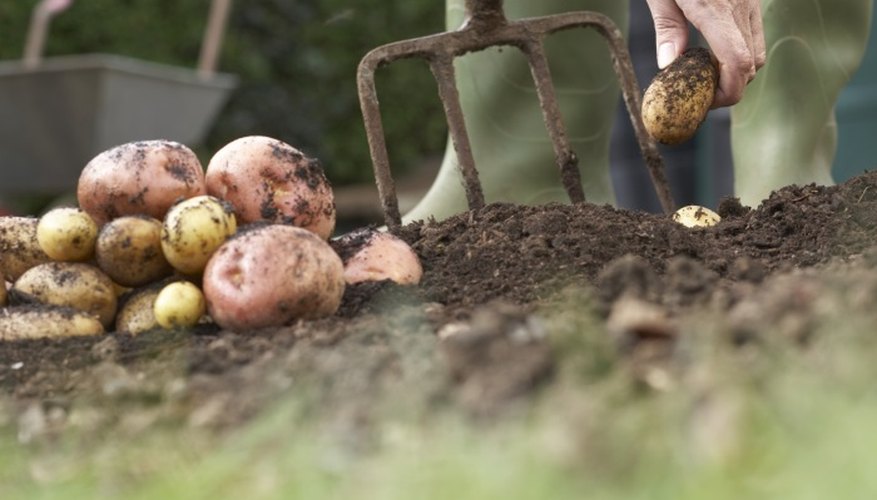The humble potato, Solanum tuberosum, is native to North America but grown the world over as a nutritious staple food and delicious dinner vegetable fried, baked, mashed or roasted. Potatoes are easy to grow in the home garden and available in hundreds of different varieties. Once planted, potatoes emerge from the soil quickly, depending on temperature, planting conditions and the variety you are growing.
Soil temperature
Seed potatoes planted in garden soil at the recommended depth of about 10 cm (4 inches) should emerge from the soil in two to four weeks, according to Cornell University. However, if soil temperature is too cold or the ground is too wet or too dry, seed potato pieces are likely to rot in the ground and not sprout, or take considerably longer to emerge from the soil. As long as the ground has warmed, sprouting potatoes that may be killed back by late-spring frosts will emerge again and grow successfully through the summer season. Hill up soil around emerging potato plants; this practice will compel them to grow longer root systems that will produce more potatoes.
- Seed potatoes planted in garden soil at the recommended depth of about 10 cm (4 inches) should emerge from the soil in two to four weeks, according to Cornell University.
- As long as the ground has warmed, sprouting potatoes that may be killed back by late-spring frosts will emerge again and grow successfully through the summer season.
Curing seed potatoes
Small seed potatoes can be planted whole, while ones larger than a small egg should be cut into pieces, with each piece containing one or more eyes from which the growth will sprout. Curing the cut seed potato pieces before planting them will help to ensure better germination rates and faster emergence, according to Cornell University, although this is a point of disagreement among experts, with the Ohio State University Extension recommending planting immediately after seed potatoes are cut. To follow Cornell's recommended curing process, put cut seed potato pieces in a brown paper bag and store at room temperature for four to six days, shaking occasionally to prevent pieces from sticking together, then plant in a prepared trench in garden soil.
Sprouted potatoes
You can speed up the potato emergence process by pre-sprouting your potatoes. Start with small, whole seed potatoes, and lay them out in a single layer in a room that receives sun and keeps a temperature consistently over 15 degrees C. The potatoes will develop small green sprouts that, in large quantities, may be toxic, so don't eat your greened potatoes. Plant the sprouted potatoes about 10 cm (4 inches) deep, with the sprouts pointed upwards, and the potato plants will emerge from the soil faster than unsprouted plantings. Don't plant sprouted potatoes too deeply or you will delay their emergence.
- You can speed up the potato emergence process by pre-sprouting your potatoes.
- Start with small, whole seed potatoes, and lay them out in a single layer in a room that receives sun and keeps a temperature consistently over 15 degrees C. The potatoes will develop small green sprouts that, in large quantities, may be toxic, so don't eat your greened potatoes.
Straw potatoes
Market gardeners looking for perfectly-shaped potato tubers, and gardeners looking to submit prize-winning large potatoes at county fair competitions, often use a method called straw potato growing. Plant by placing seed potatoes at the surface of loosened, cultivated soil, then covering with 15 cm (6 inches) of loose straw. The potato plants will emerge through the straw, usually in just 2 to 3 weeks, because they do not have several inches of soil to grow through. Add more straw around the plants as they grow and as the earlier straw layers compact. Harvest at the end of the season by pulling back the straw, which eliminates the risk of slicing tubers when digging them out with a shovel.
- Market gardeners looking for perfectly-shaped potato tubers, and gardeners looking to submit prize-winning large potatoes at county fair competitions, often use a method called straw potato growing.
- The potato plants will emerge through the straw, usually in just 2 to 3 weeks, because they do not have several inches of soil to grow through.
